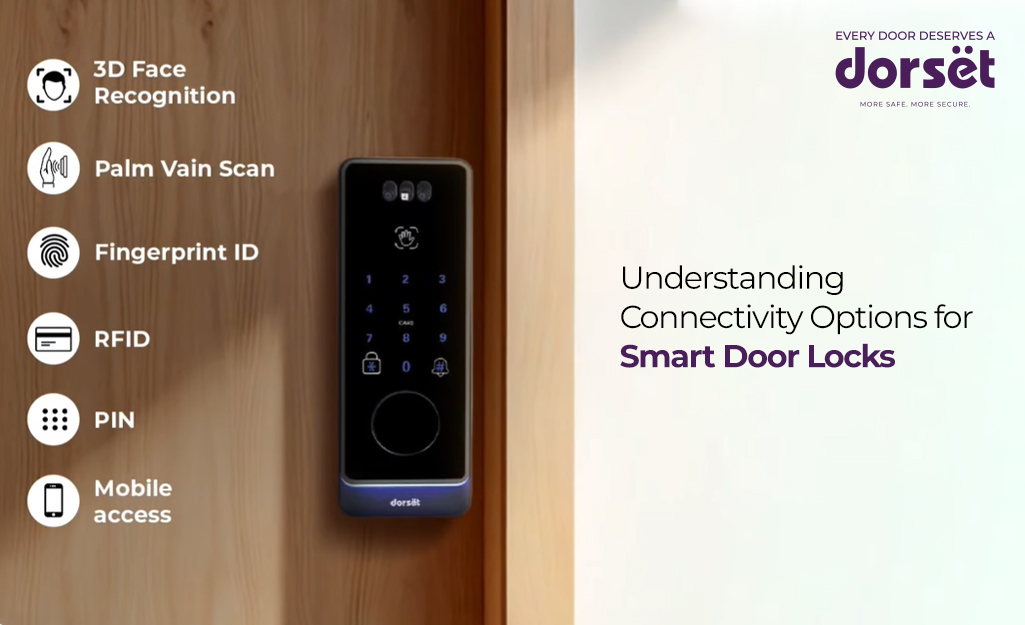
So you've decided to upgrade to a smart door lock. Great choice! But did you know that not all smart locks connect the same way? The connectivity option you choose actually determines how you interact with your lock, what features you can access, and even how reliable your system will be.
Wi-Fi: The Popular Choice with Trade-offs
Wi-Fi connectivity is probably what you think of first when imagining a smart lock. It's direct, familiar, and lets your smart door lock connect straight to your home internet without needing additional hardware. You can control your lock from anywhere in the world, check if you remembered to lock up, and even let in visitors while you're at the office.
But Wi-Fi locks come with some realities you need to consider. They consume a lot of power and will drain batteries faster than other options. If your router goes down, your remote access goes with it (though locks that are supported with local features like fingerprint and password access still work). And if you have a large home with Wi-Fi dead spots, placement becomes crucial.
Our Aero+ DG905 lock, for example, comes with Wi-Fi connectivity but it also comes supported with fingerprint and password access as well as a drained battery quick fix. You can also integrate a video camera, making it perfect if you want comprehensive remote monitoring.
Bluetooth: Simple and Battery-Friendly
Bluetooth connectivity offers a sweet spot between functionality and battery life. You'll get smartphone control when you're near your door (typically within 30-50 feet), which covers most practical scenarios.
The range limitation is actually a security feature in disguise. Nobody can hack your lock from across town because they'd need to be physically close to your home. Battery life is a little better than Wi-Fi options, and setup is usually simpler.
However, you'll lose remote access capabilities. You can't check your lock status from vacation or let in a repair person when you're at work. For many people, this trade-off makes perfect sense. When checking out the door lock types, consider your specific needs.
Hybrid Connectivity: Best of Multiple Worlds
Some modern smart locks don't make you choose just one connectivity option. Hybrid models might combine Bluetooth for local access with Wi-Fi for remote features.
These systems give you flexibility but can be more complex to set up and manage. You might use Bluetooth for daily access, Wi-Fi for vacation monitoring, and home automation.
Range and Reliability Considerations
Your home's layout significantly impacts connectivity performance. Wi-Fi locks need a strong signal at your front door, which might require a mesh router system or extender if you have a huge home. Bluetooth locks work great for apartment living but might be limiting in large homes.
Test connectivity before finalising installation. Most smart locks offer some kind of signal strength indicator during setup. If you're getting weak signals, address the issue before it becomes a daily frustration.
Security Implications of Different Connectivity Types
Each connectivity option carries different security considerations. Wi-Fi locks are potentially accessible to anyone who can access your home network, making good router security essential. Regular firmware updates become crucial for maintaining security.
Bluetooth locks have limited range, which naturally restricts attack vectors, but they can still be vulnerable to close-range attacks.
Regardless of connectivity type, choose locks that use strong encryption protocols. Our Vogue+ DG406 surveillance model, for example, implements advanced security measures across all connectivity options to protect both access control and video data.
Integration with Voice Assistants and Smart Home Platforms
Different connectivity types offer varying levels of integration with popular platforms. Wi-Fi locks typically work directly with Amazon Alexa and Google Assistant, letting you use voice commands for basic functions. "Alexa, lock the front door" becomes possible with many Wi-Fi-connected models.
Consider which platforms you already use and plan to expand into. If you're heavily invested in Google's ecosystem, ensure your chosen lock works well with Google Assistant. Amazon users should prioritise Alexa compatibility. Our Zest+ DG205 lock, for example, is compatible with both Google Home and Alexa.
Future-Proofing Your Choice
Technology evolves rapidly, and your connectivity choice impacts how well your lock adapts to future changes. Wi-Fi standards improve regularly, and newer locks often support faster, more efficient protocols. However, they're also more dependent on your internet service and router capabilities.
Consider the manufacturer's update history and commitment to ongoing support. We regularly release firmware updates for our smart door lock lineup, ensuring compatibility with new features and security improvements.
Making Your Connectivity Decision
Start by honestly assessing your needs. Do you need remote access, or is local smartphone control sufficient? Are you building a broader smart home system, or do you want a standalone upgrade? How comfortable are you with technical setup and troubleshooting?
Consider your home's infrastructure. Strong Wi-Fi throughout? Bluetooth might be limiting. Planning other smart home devices? Locks compatible with Google Home and Alexa make sense. Want maximum simplicity? Direct Wi-Fi connection could be perfect.
Test different door lock types before you fully commit. If you are in Gurugram, you can fully experience how Dorset’s best smart locks for home work, by visiting our first customer experience center– The POD.
Your smart lock should make life easier, more secure, and more convenient. The right connectivity choice ensures it delivers on all these promises consistently.